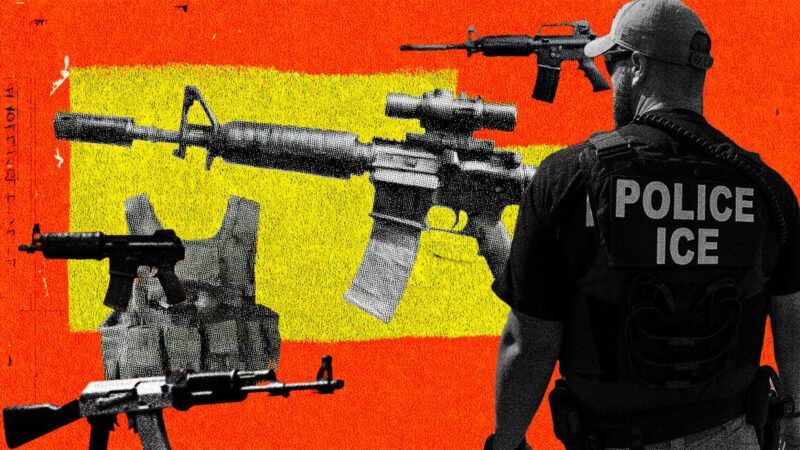ICE Spent Over $71 Million on Guns, Armor, and Chemical Munitions in 2025 So Far
The total is over 600 percent more than what the agency spent from January to October 2024.

Under President Donald Trump, Immigration and Customs Enforcement (ICE) has seen rapid growth in its budget (which has nearly tripled), personnel, and surveillance technology. New data reveal that the agency has also rapidly amassed an arsenal of small arms.
Federal Procurement Data System records show that ICE has spent over $71.5 million from January 20 through October 18 on "small arms, ordnance, and ordnance accessories manufacturing"—a 636 percent increase compared to the same period in 2024, according to an analysis by Popular Information. One bulk purchase alone on September 29 for over $9 million worth of semi-automatic and automatic rifles nearly matched ICE's entire small arms spending from January to October 2024. This single purchase also topped ICE's average annual small arms spending ($8.4 million) during Trump's first term.
While much of ICE's expansion has been justified under the guise of locating and deporting undocumented immigrants, the Trump administration has signaled a shift in priorities. After signing an executive order designating "Antifa" a domestic terrorist organization in September, federal agencies, including ICE, have begun devoting resources to investigating protestors of Trump's mass deportation campaign —many of whom are American citizens engaging in protected political speech.
The purchases analyzed by Popular Information include guns and armor, but also chemical weapons like the ones the agency has used against protestors in Los Angeles, Chicago, and Portland, Oregon. Over the last few months, ICE has been criticized for shooting pepper-balls—a projectile filled with chemical irritants—and using other non-lethal weapons indiscriminately and without warning against protestors. These actions prompted a lawsuit filed by the American Civil Liberties Union (ACLU) of Illinois in federal court, accusing federal officers of "extreme brutality" meant to "silence the press and civilians." United States District Judge Sara L. Ellis issued a temporary restraining order on October 6, limiting federal agents' use of non-lethal weapons in Chicago. Last week, Ellis expanded the order to require agents in Chicago to equip and turn on body cameras while engaging with protestors to confirm whether officers are, in fact, in compliance.
In response to allegations of excessive force, federal immigration officials told Ellis in court on Monday that ICE agents are trained extensively on how to respond to protests and make appropriate arrests. But others doubt federal immigration officers' current level of preparation. "They do not have the training or the skillset or experience to police an urban environment," Gil Kerlikowske, the former commissioner of the U.S. Customs and Border Protection under Barack Obama, told NPR. With recent reporting from NBC News finding that ICE has fast-tracked the training of recruits who have disqualifying criminal backgrounds and are physically and academically unfit for service, it seems like Kerlikowske's concerns over agents' experience and readiness are warranted.
Regardless of whether its agents are ready to lawfully and appropriately make arrests, ICE is well on its way to amassing a large amount of power through weaponry and spyware that is being used to target not only immigrants, but also American citizens who stand in the way of Trump's mass deportation campaign. With so much money already appropriated to ICE, and Congress' seeming unwillingness to check the agency's power, there's little that can be done to stop ICE's spending spree at the moment. Now it is up to the courts to ensure ICE is using its new weapons and technology in line with what the Constitution permits and to safeguard Americans' rights.


Show Comments (75)